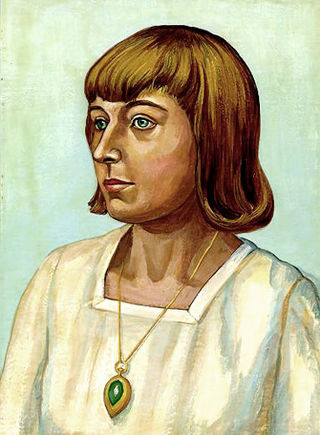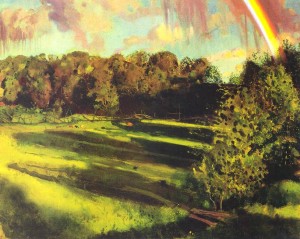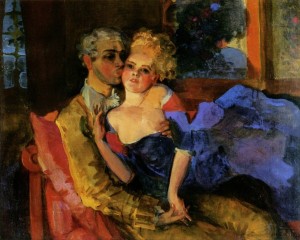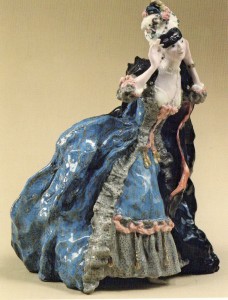
Portrait of Marina Tsvetaeva (October 8 1892 – August 31 1941).
I don’t remember for how many years I’ve commemorated the tragic suicide of Marina Tsvetaeva the Russian and Soviet poet whose verses are considered among some of the greatest in twentieth century Russian literature on this day August 31st. I think of this day as a day of mourning, the day of darkness, the day that casts the Summer away for another year.

Cemetery by Painter Vasily Polenov who was a friend of Marina's family
Marina Tsvetaeva had a complicated life; although married to husband Sergey Efron and a mother, she was an untamed passionate woman who had affairs with Sofia Parkon, Rainier Marie Rilke and an epic romance with Boris Pasternak. Then suddenly everything changed… her husband and daughter Ariadna were arrested in 1939. She escaped with her son Georgy to Yelabuga when Moscow was bombed by the Nazis. On August 31, 1941 it had all become too much and she had ended her life by hanging herself. Marina Tsvetaeva’s exact burial place was never found. Her husband, Sergey Efron, was executed in August 1941 – the same month that she committed suicide. Her 19-year-old son Mur was killed in World War II, in 1944.
'Adam, listen hard
Above the source,
Hear what rivers’ veins
Are telling their shores:
‘Beware of the graves,
More ravenous than whores.
The dead rot, they are gone
Beware sepulchers.
From yesterday’s truths
Remain filth and stench.
Give up to the winds
Your earthly ash.’
Adam, listen hard
Above the source,
Hear what rivers’ veins
Are telling their shores:
'Beware.'
(from the 1922 poem Beware, translated by David McDuff)
Because I was mourning on that day I recalled the most burning, most passionate verses of love and loss written by Tsvetaeva – Beware, The Poem of the Mountain, The Poem of the End to name just a few. But a change in my academic calendar, colored my perception of the last day of August from dark sombre tones into prettier pastels. The end of August smells different now, too. August 31 does not herald the end of the Summer vacation and the sharp transition to the school life (September 1st, rain or shine, Monday or Friday, was the beginning of the school year for more than two-thirds of my life). But today, done with all classes, on a teaching hiatus until the beginning of the academic year well into September, I am thinking about a different period in Marina Tsvetaeva’s life and poetry. And I am also thinking differently about the smells of Autumn and Fall perfume.

The Evening Shadows
As the August shadows in the evening grow darker and the nights take on a chill, I start rearranging my perfume closet; arranging my heavier Orientals toward the front of my collection. The circle of the year is turning and it is time to change white and pink roses to red ones. The fruit sorbetto is giving way to luxurious Mahjoun by Dawn Spencer Hurwitz. And sparkly florals are yielding their places in the front to one of my favorite Fall perfume category – "casual sexy". Casual sexy is the name of the game when a light lacy dress now requires a cup of warm tea or coffee and a comfy cashmere throw as supporting players. Of course, a perfume as a supporting player is crucial, at least we all think so since we’re reading CaFleureBon. I do not know anyone who does casual sexy better than Gerald Ghislain of Histoires de Parfums. I have already shared a secret of my one of my favorite gender bender 1740). It is the epitome of casual sexy and it is definitely suitable for the XXI century and yet unmistakably reminding the history fans among us of the XVIII century when men and women alike were experts in the rituals of courting which were formal and shameless at the same time.

Konstantin Somov Pierrot and Lady
I have to admit that for a while I had been secretly regretting the 1740’s name Marquise de Sade and hoping to swap the names with another famous man of Histoires de Parfums’s history – Casanova, 1725. I only regretted until I tried it on though. The citruses at the top notes rush in straight toward lavender heart, starting out as a definite cologne, almost branding a wearer as masculine. But rather soon the fragrance shows its gourmand facet. It thickens: a bright and lively cologne start gives way to a combination of lavender and licorice. Licorice swirls around, and I can almost feel as if the rush subsides and the rocket speed start slows down the way it does during a nice date. Many of us know and love the winning combination of licorice and lavender from Hermessence Brin de Reglisse and Serge Lutens’s export edition Forreau Noir. Casanova charts this more familiar territory in a different way by becoming a fragrance both masculine and powdery. It invokes an image of the XVIII century’s powdered wigs sported by men and women alike. It is when licorice and lavender blend into a lovely slightly powdery haze over my skin I start feeling both boldness and lightness, that special lightness of the XVIII century Tsvetaeva was so fond of.

Konstantin Somov Lovers
Such is the influence of a good work of art: it shapes your view. I cannot shake off Tsvetaeva’s view of the XVIII century even though I know that historically it is not always accurate. Similarly, I still harbor her more than slightly romantic view on Casanova from her plays. She wrote two, Adventure featuring Casanova in his prime and Phoenix about his last days. Adventure, tells a story of Casanova meeting a beautiful and brilliant traveler Henrietta. In the cast of characters for the play Tsvetaeva describes Casanova as “sharp angle and hot amber.” Henrietta is described as “moon ice,” but that woman, cold indeed and mysterious indeed is an adventuress who gets into Casanova’s room dressed like a young soldier (oh, we will never get over that gender bending, will we?) and is rumored to have already survived a duel. Henrietta and Casanova fall for each other, but she sees through him very clearly. Despite the vows of love she declares, “You will never love this way any more, but will love thousand more ways. More passionately, but never more strangely” and writes on a glass with her diamond ring, “You will forget Henrietta, too.” Oh well. He does. He does remember as well, but I am not sure whether this counts – he remembers thirteen years later after his girlfriend-for-the-night reads what’s written on the window. He remembers Henrietta, mourns his loss of her… and turns back to the girl. Perhaps, for the whole length of that night. I cannot guarantee that next night he will be on the girl’s side again, sorry. Nor can I guarantee that he remembers Henrietta next morning by the time Casanova fragrance transitions from lavender to a deep woody-amber-vanilla accord. Did I forget to mention that the drydown of Casanova is undeniably casual sexy?

Somov Lady taking off a mask (porcelain)
No, one cannot count on Casanova. One cannot count on Henrietta, as she leaves Casanova as soon as she receives a mysterious envelope with seven seals and demands him to never seek her and to never let on that they knew each other. We will never find out who she is. One cannot count on a poet – a poet is not meant to be taken literally. One cannot count on the wheel of the year always turning the same way, as you can see from my example. One cannot even count on our favorite perfumes – they are gone, the glass bottles are shattered on hotel bathroom floors, the vapors dissipating from the sealed vintage bottles, they are reformulated, discontinued, and we mourn the loss. All we can count on is an experience we have today, like putting perfume on and letting it smell our days the way we let the candle burn away. You cannot even count on your perfume being the same on your skin every time. It may even bring different smells and different stories each time. But I can count on smelling the Casanova fragrance and not forget neither him nor Henrietta because histories are the stories that are written down not to be forgotten, be it written on a window with a diamond ring, on a paper with a pen, or in our mind with a winning combination of a perfume and a story.
Olga Rowe, Contributor






